Utah's Seasons
Utah is a very large state that runs from N 42nd degree to the N 37th degree latitudinal parallel so there are widely varying conditions from Northern Utah to Southern Utah. In 1985, Utah recorded two record cold and hot temperatures of -69.3 F (-56 C) at Peter Sinks in February and 117 F (47 C) six months later in July in St. George.
There are four strong Utah seasons that have distinct weather patterns — the most pleasant weather usually occurs between late April to mid-June and late August to mid-October. From December through February, the valley is prone to prolonged inversions with high levels of fine particulate pollution, meaning the air quality can be poor, especially for sensitive groups.
Utah primarily has a dry, semi-arid and desert climate. It is one of the driest states in the country with one of the lowest relative humidity percentages. In December the average highest relative humidity is 74.3% and in July the average lowest humidity is 35.9%. This is why people say it’s a "dry heat." Ninety degrees fahrenheit in Utah (32 C) feels much more palatable compared with a place that has high relative humidity, like Florida, which makes it feel hotter and muggy.
Conversely, we also have "dry cold," meaning Utah’s air doesn’t feel as bitterly cold during the deepest weeks of winter as it does in places like the coastal New England because it lacks humidity. The lack of humidity and moisture in the atmosphere makes the skies above Utah a deeper shade of blue.
"There are four strong Utah seasons that have distinct weather patterns — the most pleasant weather usually occurs between late April to mid-June and late August to mid-October."
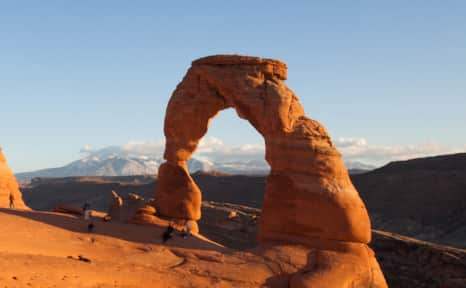

Delicate Arch at Arches National Park
-
Fall
The beginning of September can still bring hot days, but this is generally when temperatures start to cool. There are approximately six days of rainfall and daylight hours dwindle. Leafs start to change color in September and really hit their stride by October. In October, temperatures continue to cool, leaves continue to change color and snow begins to fall, though it usually doesn’t accumulate. By November, temperatures have gone from warm to cold and rain falls for nine days on average during the month. Snow begins to accumulate in the mountains and ski resorts tend to open toward the end of the month.
-
Spring
March begins with cold weather at the start of the spring season in Utah. Early spring is prone to cold fronts, and the arid land has sizable daily temperature differences. A moderate amount of rain falls in March, and the rest takes the form of snow. In April, temperatures rise with the advance of the spring season in Utah. Measurable snowfall recedes and most ski resorts end operations mid-April. Spring blooms, rain showers and increasing sunshine dominate the last two weeks of April. Typically, May is a very pleasant month across the state. Temperatures are moderate, the length of the days and sunshine are longer and there are enough rainstorms to keep it cool.
-
Summer
In June, summer kicks off with enjoyable temperatures, abundant sunshine, and occasional rainfall. June has the longest days of the year, peaking at 15 hours of daylight on the summer solstice. July and August are the warmest months of the year with the same range of average high temperatures. These are the driest (least humid) months with the least amount of rainfall.
-
Winter
Winter lasts from December through February with long periods of snowfall, freezing temperatures and short daylight hours. December and January are the coldest months of the year. The shortest day is December 21, (winter solstice) with just nine hours of daylight. February brings a mix of winter and spring weather with sneak peeks of warmer temperatures and more sunshine.
Utah Regional Averages
Winter and Spring Temperatures
Region |
Jan. |
Mar. |
May |
|
Top of Utah |
31/11 F -1/-12 C |
48/26 F 9/-3 C |
69/41 F 21/5 C |
|
Wasatch Range |
36/19 F 2/-7 C |
52/31 F 11/-1 C |
72/46 F 22/8 C |
|
Eastern Utah |
37/12 F 3/-11 C |
49/23 F 9/-5 C |
68/37 F 20/3 C |
|
Central Utah |
39/9 F 4/-13 C |
50/21 F 10/-6 C |
77/42 F 20/2 C |
|
Southeastern Utah |
42/18 F 6/-8 C |
62/33 F 17/1 C |
82/48 F 28/9 C |
|
Southwestern Utah |
53/25 F 12/-4 C |
67/36 F 19/2 C |
86/51 F 30/11 C |
|
Southcentral Utah |
46/24 F 8/-4 C |
62/35 F 17/2 C |
83/51 F 28/11 C |
Summer and Fall Temperatures
Region |
July |
Sept. |
Nov. |
|
Top of Utah |
89/54 F 32/12 C |
77/43 F 25/6 C |
46/24 F 8/-4 C |
|
Wasatch Range |
92/62 F 32/16 C |
79/51 F 26/11 C |
50/29 F 10/-2 C |
|
Eastern Utah |
87/51 F 31/11 C |
75/41 F 24/5 C |
46/22 F 8/-6 C |
|
Central Utah |
83/48 F 28/9 C |
73/39 F 23/4 C |
49/18 F 9/-8 C |
|
Southeastern Utah |
99/63 F 36/16 C |
87/51 F 30/11 C |
57/28 F 14/-2 C |
|
Southwestern Utah |
102/66 F 37/18 C |
93/55 F 34/13 C |
65/32 F 18/-1 C |
|
Southcentral Utah |
99/67 F 37/19 C |
87/57 F 31/14 C |
57/33 F 14/1 C |
Annual Precipitation
Region |
Average Precipitation |
|
Top of Utah |
17.2" |
| Wasatch Range Ogden, Salt Lake City, Provo. Park City averages five to 10 degrees F cooler. |
19.13"/16.1"/13.26" |
|
Eastern Utah |
9.31" |
|
Central Utah |
8.15" |
|
Southeastern Utah |
8.8" |
|
Southwestern Utah |
14.64" |
|
Southcentral Utah |
11.34" |
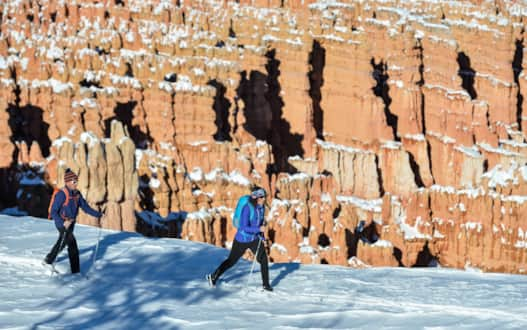
Photo: Hage Photo

Photo: Matt Morgan
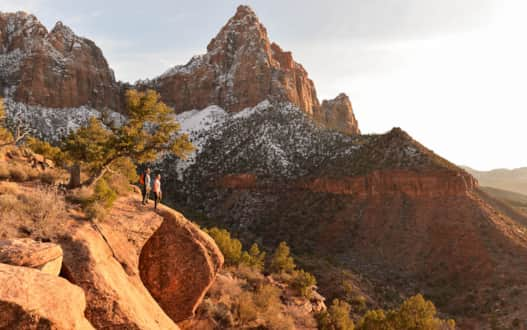
Photo: Matt & Agnes Hage
Arches National Park
Temperatures in Arches National Park range from 44/22 F (6.6/-5.5 C) in January to 100/67 F (38/19 C) in July. As part of the Colorado Plateau, this high desert region experiences wide temperature fluctuations, sometimes more than 40 degrees in one day.
For more detailed information visit the Arches National Park page on the National Park Service website.
Bryce Canyon National Park
In Bryce Canyon National Park, temperatures range from 37/15 F (2.7/-9.4 C) in January to 80/53 F (26/12 C) in July. Due to its high elevation (7,664 feet/2,335 meters), the park experiences much cooler weather than the other national parks in Utah.
Visit the Bryce Canyon National Park page on the National Park Service website for more details.
Canyonlands National Park
In Canyonlands National Park, temperatures range from 44/22 F (6.6/-5.5 C) in January to 100/67 F (38/19 C) in July. Canyonlands National Park is also a part of the high desert region of the Colorado Plateau and experiences wide temperature variations within a single day.
Visit the Canyonlands National Park page on the National Park Service website for more information.
Capitol Reef National Park
Capitol Reef National Park temperatures range from 41/20 F (5/-6 C) in January to 91/65 F (33/18 C) in July. The unique environment of Capitol Reef presents many weather-related safety concerns such as flash flooding and heat risk.
Learn more about Capitol Reef National Park’s weather on the National Park Service website.
Zion National Park
Temperatures in Zion National Park range from 52/29 F (11/-1.6 C) in January to 100/68 F (38/20 C) in July. Daytime and nighttime temperatures can vary by more than 30 degrees and certain areas are prone to flash flooding.
Check the Zion National Park page on the National Park Service website for up-to-date information on park weather.
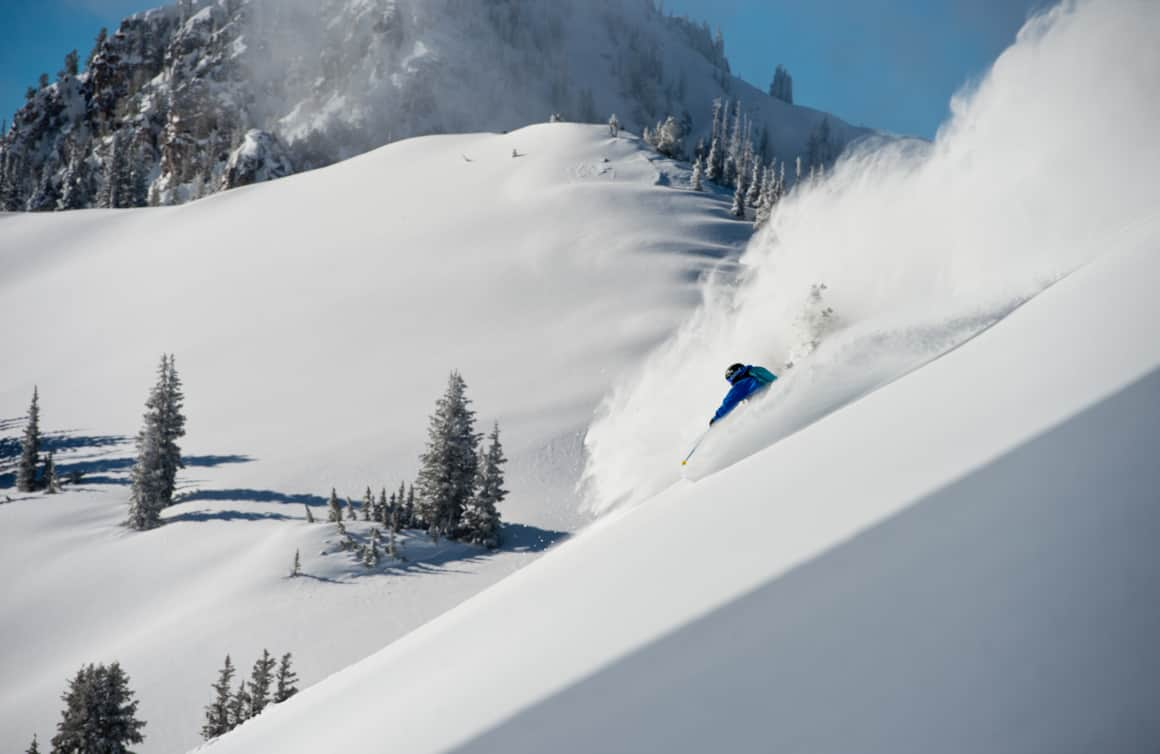
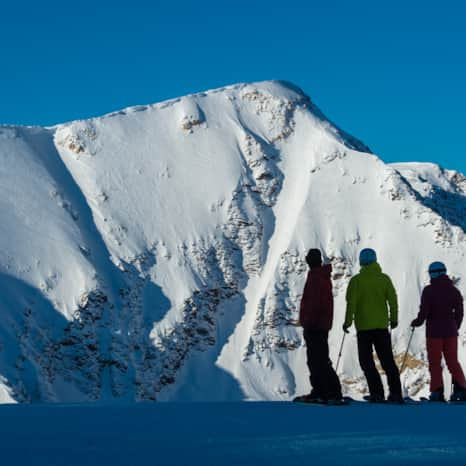
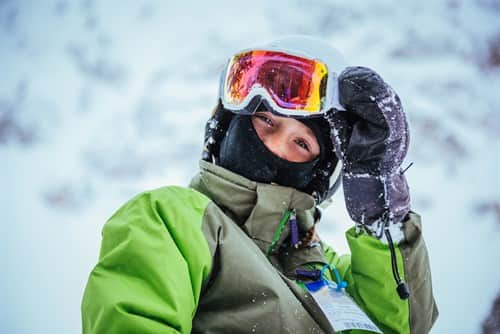
Utah Ski and Snowboard Weather
Utah has 15 ski resorts across the state. Resorts are typically open from the end of November — depending on early season snowfall — through mid-April. The Cottonwood Canyons receive an average annual snowfall of 551 inches (1,397 cm). The snow density is around 8.5 percent, which makes Utah’s snow powdery. There are more than a dozen powder days each season. Powder days happen when more than 12 inches (30 cm) falls within 24 hours. Learn more about the science behind The Greatest Snow on Earth.
Daily Snow Conditions
Every resort will post daily updates about their current conditions. Many also have links to webcams so you can get a live look of the mountain. See current conditions.
Weather Alerts
You can watch weather reports and forecasts on Utah’s four main television broadcast channels: KUTV (CBS) Channel 2, KSL (NBC) Channel 5, ABC4 (ABC) Channel 4, KUED7 (PBS) and FOX13 (Fox) Channel 13. Local news programs begin at 5 p.m., 6 p.m., and 10 p.m.
You can listen to local weather information on NOAA Weather Radio.
The Unified Police Department operates a canyon alert system to let people know about canyon traffic information including restrictions such as tire chain requirements in the Cottonwood Canyons. You can follow these alerts on Twitter: @UDOTcottonwoods and by “liking” their Facebook Page.
Transportation
Utah’s mountains receive frequent, heavy snowfall. While this is great for our winter recreation opportunities, it also presents winter driving safety challenges. Ski buses run regularly to the Cottonwood Canyon resorts (Alta, Snowbird, Brighton, Solitude). Review best practices for driving in the Cottonwood Canyons to stay safe and avoid congestion.















